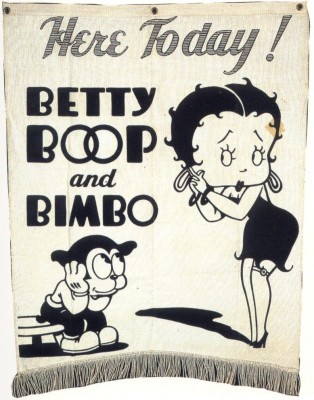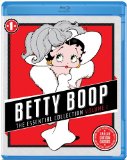| Reviews & Columns |
|
Reviews DVD TV on DVD Blu-ray 4K UHD International DVDs In Theaters Reviews by Studio Video Games Features Collector Series DVDs Easter Egg Database Interviews DVD Talk Radio Feature Articles Columns Anime Talk DVD Savant Horror DVDs The M.O.D. Squad Art House HD Talk Silent DVD
|
DVD Talk Forum |
|
|
| Resources |
|
DVD Price Search Customer Service #'s RCE Info Links |
|
Columns
|
|
|
Betty Boop: The Essential Collection, Volume 1
But Betty's best, the two-dozen or so cartoons from 1932-34, and even many of those made later on, positively ooze the Fleischer house style, one more adult and surreal than his rivals, with imagery at times more Dali than Disney. As animation historian Leonard Maltin and others have pointed out, where Disney exploited the natural fears of children, the Fleischers' cartoons explore the darker psychology of adults. (This is not to say kids can't enjoy them, too. My nearly six-year-old couldn't get enough of "that little girl.")
Though hugely popular in their day, probably because the Betty Boop cartoons were made in black and white, their marketability has (nonsensically) been limited in recent decades. Further, like various Popeye cartoons and most (all?) of the Superman cartoons, many Betty Boop shorts have fallen into public domain, and home video versions of those shorts have been of variable quality.
Betty Boop - The Essential Collection, Volume 1 is an Olive Films release of 12 non-public domain shorts licensed from Paramount, the series' original distributor. (The Fleischer family retained at least some rights to the character. When I visited the home of Max's son, director Richard Fleischer, over several days to record a DVD audio commentary track, it was in a den-office filled with Betty Boop merchandise his family had licensed.)*
The shorts have been remastered in 4K using the original negatives and, in some cases, fine grains. However, because the shorts are preceded by U.M.&M.TV Corp. logos from about 1955, some reviewers have wrongly assumed that these may be sourced from dupes created later for TV syndication. To my eyes, most of the shorts appear derived from their original negatives, and that probably the Paramount logos were spliced off and these TV syndication logos spliced directly onto the original negative.
What's important though is that these logos aside, the shorts themselves all look fantastic, especially considering their age, convoluted ownership and distribution history. I was a bit dismayed that the set contains just 12 cartoons (total running time: 84 minutes), and that Olive is organizing these sets out of chronological order and without extra features (as Warner Home Video did with its Fleischer Popeye DVDs). But if the trade-off is shorts looking this good, I'm all for it. It's also possible Olive may have deliberately chosen shorts a bit "safer" and more family-friendly for this first volume, as a means to easing Betty's reintroduction to today's audiences. At least viewers don't have to contend with endless disclaimers of the type found on Disney and Warner PC releases.
Though Betty Boop's first screen appearance was in the 1930 short Dizzy Dishes, the set opens with Chess Nuts from 1932, concentrating on the pre-Code era and followed by Betty Boop, M.D., Betty Boop's Bamboo Isle, Betty Boop for President (all 1932), Betty Boop's Penthouse, Betty Boop's Birthday Party, Betty Boop's May Party, Betty Boop's Halloween Party (all 1933), Betty Boop's Rise to Fame, Betty Boop's Trial, Betty Boop's Life Guard (all 1934), with one significantly later, post-Code Betty Boop, The Foxy Hunter (1937), tossed in as a good example of the later shorts.
Betty was, initially, modeled by artist Grim Natwick as a kind of combination French poodle (complete with floppy ears, long gone by 1932) and singer Helen Kane, whose "boop-boop-a-doop" voice and face were similar. (Thankfully, Kane did not share Betty's gargantuan, misshapen head.) Kane was not compensated and later sued the Fleischers and Paramount, but she lost the battle when it was discovered Kane herself had based her singing style on Baby Esther, an African-American performer at the famed Cotton Club.
At least five actress alternated in providing Betty's Helen Kane-like voice, most famously (and perhaps most frequently) Mae Questel, who was also the primary (but not only) voice of Olive Oyl in the Popeye cartoons. An elderly Questel voiced Betty for the character's cameo appearance, appropriately in black and white, in Who Framed Roger Rabbit (1988), Betty's first movie appearance in nearly fifty years.
The appeal of these shorts lay in their profoundly surreal animation, with a particular interest in the hallucinatory, usually some combination of innocent and not-so-innocent sex, ghoulishness (skeletons jumping out of their skins is a familiar motif), and red-hot jazz (Louis Armstrong, Don Redman, and most famously a rotoscoped Cab Calloway "appear" in several shorts and/or are heard on the soundtrack). Unsurprisingly, the shorts became quite popular with those partaking in the reefer, man.
Part of Betty's charm was her innocent, even girlish yet explicit sexuality, a combination of sweet and saucy almost impossible to pull off in today's much more prudish, politically correct climate. She was no man-eater like Mae West, but Betty was equally seductive in her short dress (so short as to reveal an ever-present garter) and curvy hips. And then there were Betty breasts. In Betty Boop's Bamboo Isle for instance, Betty (again, adapted from rotoscoped movements) does a highly suggestive hula wearing a grass skirt and lei, her breasts teasingly jiggling behind it.
In some of the shorts villains, usually towering over her and many times her size, clearly want to ravage her generally, while in other shorts the bad guys explicitly commit what would be called sexual harassment today. But, helped by friends Bimbo the Dog and Koko the Clown, Betty always prevails. "Nope," as she declares in one short, "He couldn't take my boop-boop-a-doop away."
Bimbo, known earlier as Fritz, and Koko were both veterans of the Fleischers' silent era "Out of the Inkwell" series, with Koko and Fritz debuting in 1919 and 1923, respectively. (This reviewer's list of Top Ten Animated Shorts would have to include Ko-Ko's Earth Control, a truly mind-blowing cartoon from 1927-28. It's available on YouTube.) Some of the Betty Boops here similarly feature live-action introductions, with Betty emerging or disappearing into a filmed inkwell, and Max Fleischer himself is featured in Betty Boop's Rise to Fame.
Video & Audio
As described in more detail above, Betty Boop - The Essential Collection, Volume 1 consists of 12 one-reel shorts on a single Blu-ray disc. The shorts, remastered in 4K from their original negatives and fine grains, retain the spliced on U.M.&M.TV Corp. logos but otherwise look spectacularly good. Three more volumes are promised (Volume 2 is slated for September 24th), though that would seem to fall well short of Betty's entire Fleischer filmography.** The DTS-HD Master Audio English mono soundtracks sound good considering their age and technical limitations. No subtitle options and no Extra Features.
Parting Thoughts
A must-have for animation buffs and a set guaranteed to enchant child and adults alike heretofore unfamiliar with these phantasmagorical cartoons, Betty Boop The Essential Collection is a DVD Talk Collector Series title.
* The space had been a projection and screening room, but in the early ‘70s Fleischer wanted it converted into an office and hired a free-lance carpenter to do the job. When the room was halfway finished, the carpenter vanished without saying a word, leaving lumber, sawhorses and the like everywhere. He returned just as suddenly weeks later, apologizing profusely to an angry Fleischer, explaining that he was also a struggling actor who had landed a last-minute job he just couldn't turn down. Fleischer accepted the apology, and Harrison Ford finished building Fleischer's office.
** Animation buffs and historians, while praising the high-quality of the transfers, are expressing concern that Olive's planned 49-cartoon collection needlessly omits many cartoons featuring Betty Boop because project managers at Paramount and/or Olive aren't fully aware of their holdings and of Betty's various appearances, and/or deliberately want to avoid those cartoons already in the public domain. However, there's much confusion over this, with Olive reportedly misinformed about which titles are PD and which are not. (This is odd because Olive has released a few PD features to rave reviews and, one hopes, brisk sales.) Also, some complain that the movies are being optically stretched, as the Fleischers were among the last to use a 1.2 (not 1.33:1 or 1.37:1) aspect ratio during the early talkie era. In essence, circles are stretched into ovals.
My feeling is that up to now Olive has done a near-perfect job with their Blu-ray discs of Paramount-owned titles (including from the Republic library). In this case, they'd probably benefit from the free expert advice being offered them by highly respected animation historians (not Home Theater Forum angry mob types) who want the same thing they do: the best-possible release.
Stuart Galbraith IV is a Kyoto-based film historian whose work includes film history books, DVD and Blu-ray audio commentaries and special features. Visit Stuart's Cine Blogarama here.
|
| Popular Reviews |
| Sponsored Links |
|
|
| Sponsored Links |
|
|
| Release List | Reviews | Shop | Newsletter | Forum | DVD Giveaways | Blu-Ray | Advertise |
|
Copyright 2024 DVDTalk.com All Rights Reserved. Legal Info, Privacy Policy, Terms of Use,
Manage Preferences,
Your Privacy Choices | |||||||













